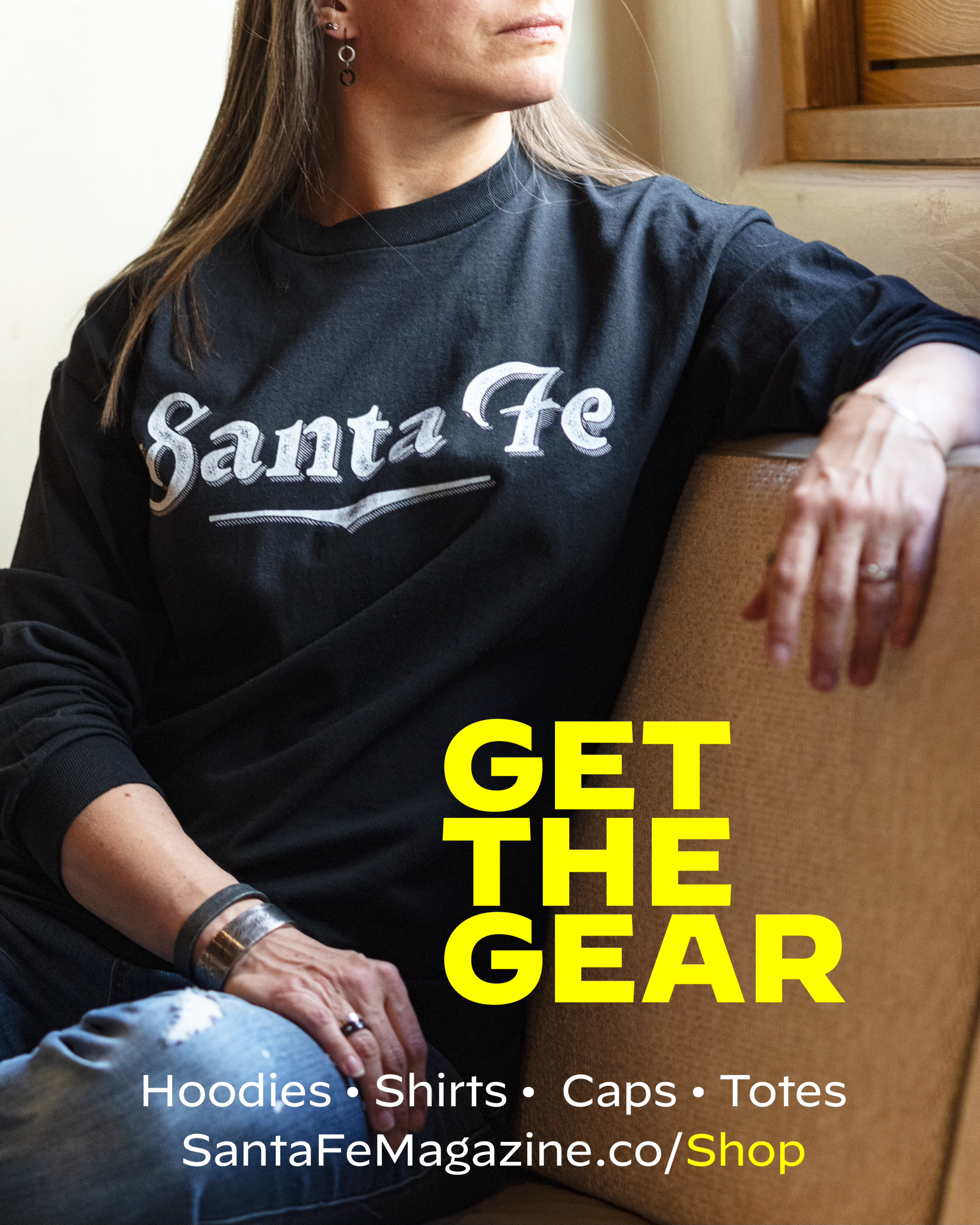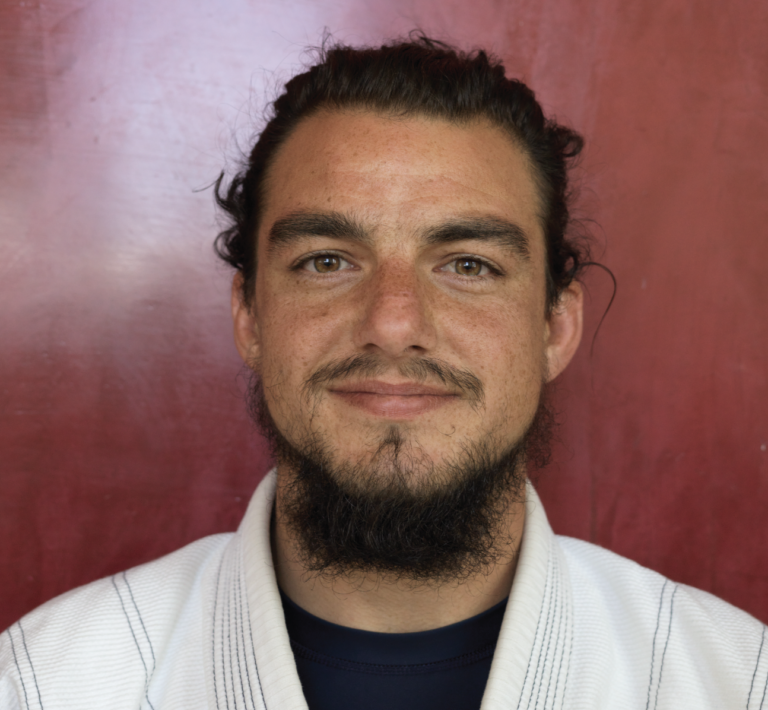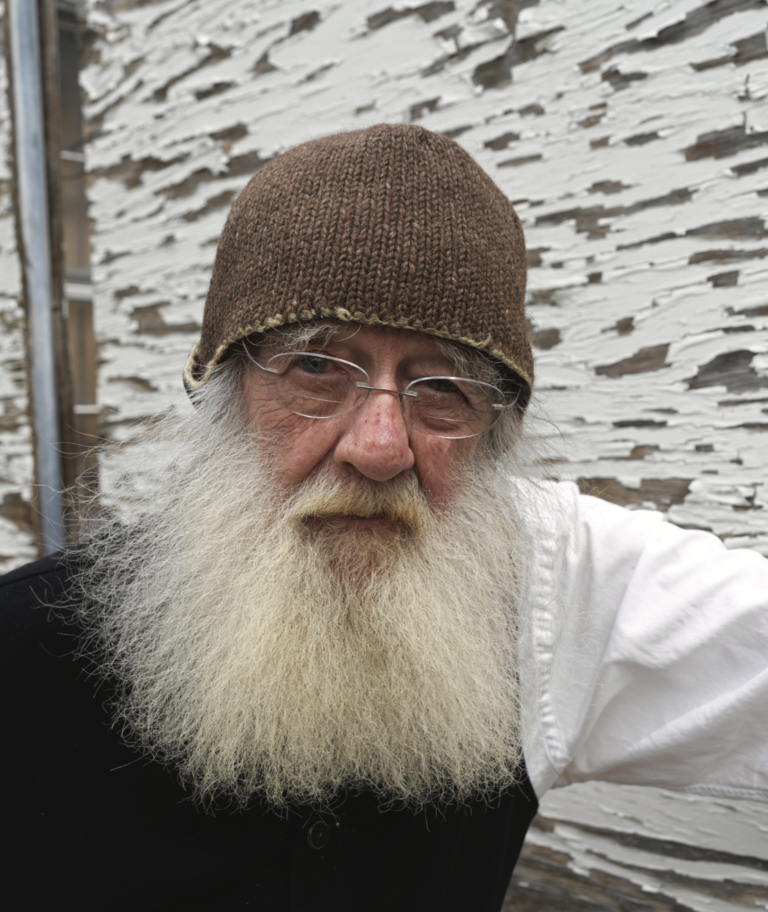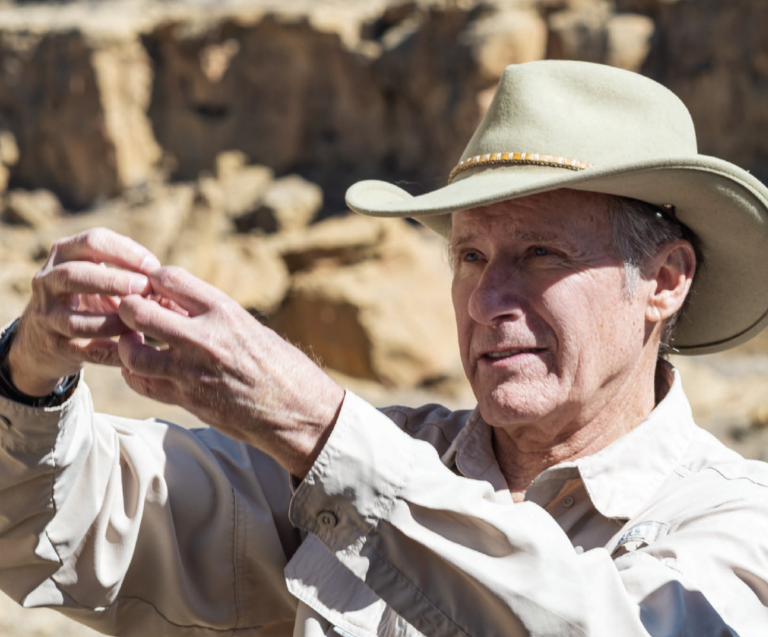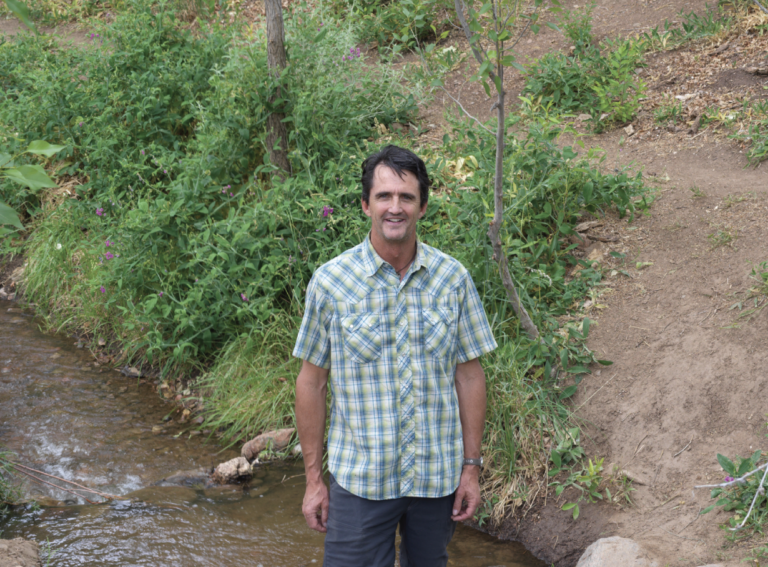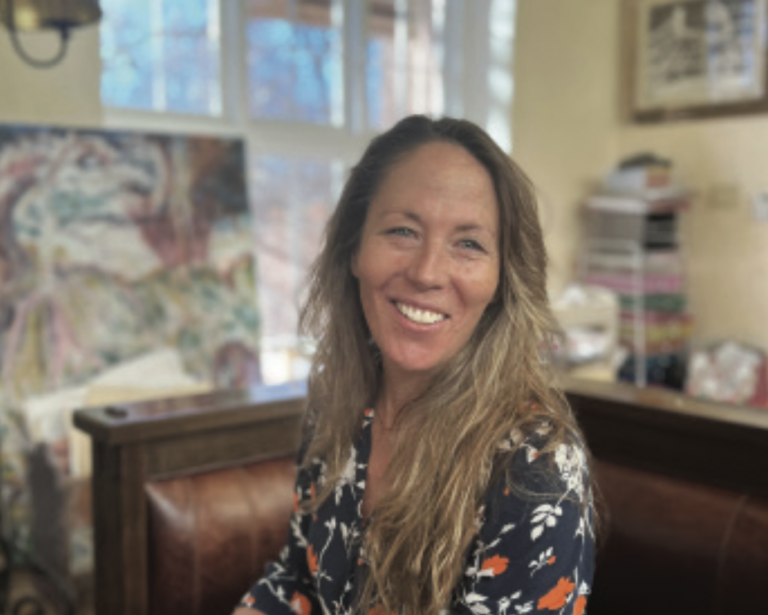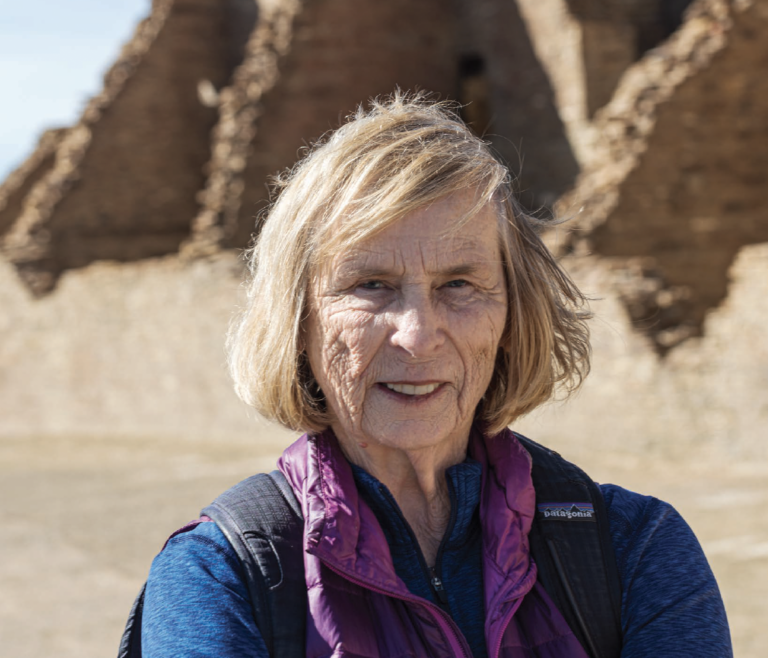YOU CAN’T GET TO NICHOLAS HERRERA’S HOME in El Rito with a GPS. Try Siri and you’ll end up in an infinite loop.
The final directions to his ancestral home came from his girlfriend, a National Geographic photographer, who travels the world. The old-fashioned directions read something like Call from the village, go left at the grocery store, up the lane, look for blue sign, etc. It was a wintry day and with the drive though the desert, the day held out the promise to be very robust.
I was glad I visited his home. Everything he cares about is right there. Behind his modest house is his cherished junkyard of art supplies and relics, all soon to be re-purposed. In his adjacent barn garage is an impeccable 1948 Chevrolet. He restored it, despite being, as he says, an incapable mechanic. Around the yard are several large works all going on at the same time. And his mother is buried in a chapel he made for her near the living room.
Nicholas is a brilliant, untrained outsider artist. The heart of why he does what he does is both a mystery and an entirely logical way to make sense of the world.
To his surprise, a lot of fancy people have taken note of his unique take on the world. Go figure.
When did you figure out you were an artist?
I’m dyslexic. When I was a little kid they threw me in special ed in third grade. I couldn’t do figuring, couldn’t add, couldn’t subtract. When you’re dyslexic, you don’t work the same. I was kind of out of control already, drinking a lot, doing drugs and this friend of mine, Bob Baker’s his name, said, You should be in the studio tour because you do some cool stuff. I was always doing art, but I didn’t even know I was an artist.
My great-great-great grandfather’s brother was José Inés Herrera. His work is in museums. He was El Santero de la Muerte — the Angel of Death. He carved a lot of those angels of death for Penitente Morada, for the Penitentes. I got inspired to that by seeing his work.
When you started painting what happened?
I was painting retablos, and I was carving little animals. My mom was one of the supporters of my art too, because my mom worked for artists here in El Rito. She used to clean their homes. And I used to go with her to the homes and hang out with her. A lot of these artists would give me brushes or leftover stuff. And then one of them was a professor at Kent. And he took me to my first art show in Taos. Some young kids were even showing their work, so I got inspired to all that. And she took me to see Georgia O’Keeffe when I was like 12.
Really? What was that like?
Georgia O’Keeffe? I liked her oatmeal cookies. I don’t know, she was an old lady. But it helped me to think, you know what? I don’t want a fucking boss, you know what I mean? I want to do art. So it was in my mind already. But I had to go through death, I had to go through drugs, I had to go through drinking, I had to go through hell to do what I do now.
Why do you think you had to?
I think it was hereditary, it’s passed on. My grandfather was in World War I, and he passed it on. A lot of those guys came with PTSD and they didn’t have no cure for that. Then my dad was in World War II. He was a tunnel rat, they didn’t even speak English. They got sent to the War and tons of discrimination and when they came back — no help. A lot of that was passed on from generation to generation. And then my brother was in Vietnam. I hung out with him and he was pretty wild, so my mentors were out there.
You also had a near death experience, a car accident.
What happened is, one night, I went head-on with some guy, hit me head-on. I flew out of a Yugo going like 80 miles per hour. I was like 22, 23 and I almost died. I flew to one side of the road and it was Christmas Eve and it was snowing, I almost froze to death. And somebody finally found me. I made up with it, man. I came outta my own body, I could see my death.
I went through this river that I was like, I really, really loved it. I didn’t want to come back.
What made you come back?
I think the spirit wanted me here.
I was in a coma and they told my mom that I was gonna die, and my mom’s like, he’s not gonna die. My mom knew that I wasn’t gonna die. She was my support.
I was in a coma for a few days. But when I woke up, there’s cops right there on the door waiting for me, because I had so many warrants. I had all kinds of shit. And I never went to court, I just threw the tickets away and shit like that.
But it was bad. I couldn’t even walk, man. Years later I went to a chiropractor and they said, You broke your back! And in those days, they were giving you Percocet. They gave me a shitload of Percocet. And I didn’t want to get hooked, I saw too many people were going down with Percocet and then heroin.
I just started cutting the pills and I started crawling out of the sofa. You know what I mean? I was really fucked up. But I was determined that I wasn’t gonna drink again. I didn’t want to go there no more.
I went off the wagon once and that was it, but it’s been 30 years. That really don’t count. But people found out that I’m still fucked up in the head because I got drunk. It don’t go away, you know what I mean?
Later, I was caught for driving without a license, and I had all kinds of shit on me already. So they threw me in the Los Alamos jail for, I think it was four months or something like that. I began sketching, and one of the jailers said, Man, I really like your work; your sketches are cool. And I said, Well, let’s trade for cigarettes. I kept making sketches for him and then the day I was gonna get out, he said, My wife is the curator of the Cougar Lodge and she wants you to have a show. So that was good. I thought, I’m not fucking this one up!
After that happened, I started doing political art about Los Alamos. I did the Los Alamos Death Truck, which is a pretty famous piece. It’ll be in the Harwood show next fall. It’s about radioactive waste. Then I did a piece about discrimination, about when I was being beaten up by the cops. That one is in the Smithsonian.
Catholicism is very manifest in your work.
It’s about experiences that I went through, that’s what it’s all about. A Santero carves saints and stuff like that. But I was beyond that, you know what I mean? I was, I am a Santero, in the root, but I have jumped to the other side, you know what I mean? And some people are like, Oh, you’re sacrilegious, and I’m not fucking sacrilegious. Look at Jesus! Jesus will come into the world right now and they’d put him in the back of a cop car. They’ll think he’s a hippie and kick his ass.
I made a door for my daughter when she was a little girl. It has San Isidro, the patron saint of farmers on it. It’s a lot about the land here. He’s taking care of the land. Then we have the patron saint of evil. He keeps evil away.
How does he do that?
He has a sword and he’s like, you get your shit together, and now you’re going to get the sword. It’s like saints in the day were pretty cruel. They had a role, they had specific roles.
Another one is a patron saint of battered women. She didn’t wanna marry the king, so she grew a beard.
Why is she on the cross?
Because she feels like she was crucified. They crucified her because of that.
How does having dyslexia affect the way you look at the world?
It makes you stubborn and you don’t want people pushing you around. You know what I mean? You wanna do your own thing. I’d lock up my studio and I’m in the studio. You know what I mean? I’m like, sometimes you want to keep away from everybody. Dyslexia does that because you don’t want people to know how stupid you are when you’re a kid. It’s like, just gimme some crayons and a paper and I’m okay. It’s therapy.
Do you think of yourself as an outsider artist?
When I was showing in New York, I showed with outsider artists. I didn’t even know I was a fucking outsider artist. I knew I did folk art. Those guys in New York were really outside, you know what I mean? A lot of disabilities in great artists. Like Sinister and Mr. Imagination from Chicago and Lee Godie from Chicago. A lot of people that are now dead, but their work is all over the world. It’s famous now.
What’s a typical day in your life?
I just get up, I have my coffee and look at the news sometimes.
Is your art something that comes with spurts and guesses?
It’s like building a car, you know what I mean? I just got to go in there and do it again, and I don’t plan it. I’m not a very good planner. I go in there and I start a piece, I don’t sketch anything I’ve done. I start something and then it works itself, it starts speaking to me.
It’s spontaneous?
They just come. This is the ancestors.
Do you feel like they’re here?
I feel good when I’m here. I feel the energy. It gives you a lot of memories, you know what I mean? My mom got Alzheimer’s, she got real sick and I had to ask her what she wants to do when she passes away.
What did she say?
She came here with her walker and she goes, bury me right there and you make me a St. Anthony chapel. So I did it. And then I got the shovel and just threw in a marker and in Spanish she goes, I ain’t dead yet, you son of a bitch! We were always joking till the end. You know what I mean?
Your mother always saw something in you.
Since I was little. She said, you’re gonna do something with your life. You know, she got to see me at least do some shows. She even had a show with me in Taos because she was a folk artist, too.
A Spanish woman around here was just a cleaning lady. And they were only cooks and they took care of all their kids. There was no such thing as a Hispanic woman being an artist here.
So, I made myself, you know what I mean? Nobody made me. I made myself the hard way. But I had the support of my mom. And the family.
My mom was the one who first called the AA guy. I remember that day. She called him on the phone and his name was Dave Ferulli. And she said, Mr. Ferulli, I want you to help my son. I think he’s dying. I was over here passed out, one eye open and a bottle of tequila here and a .44 Magnum on the other side.
Did AA work?
It worked for a while, you know, until I went on a binge. And I landed up going to court-required AA. It’s like if you have to go, you don’t care, but when you want to do it on your own, you do it.
Do you think you had to go through all that suffering?
We gotta suffer to become who we are. When you get something really easy, it’s like you didn’t work for it. You know what I mean?
Learn more at EvokeContemporary.com
Photo Beth Wald

